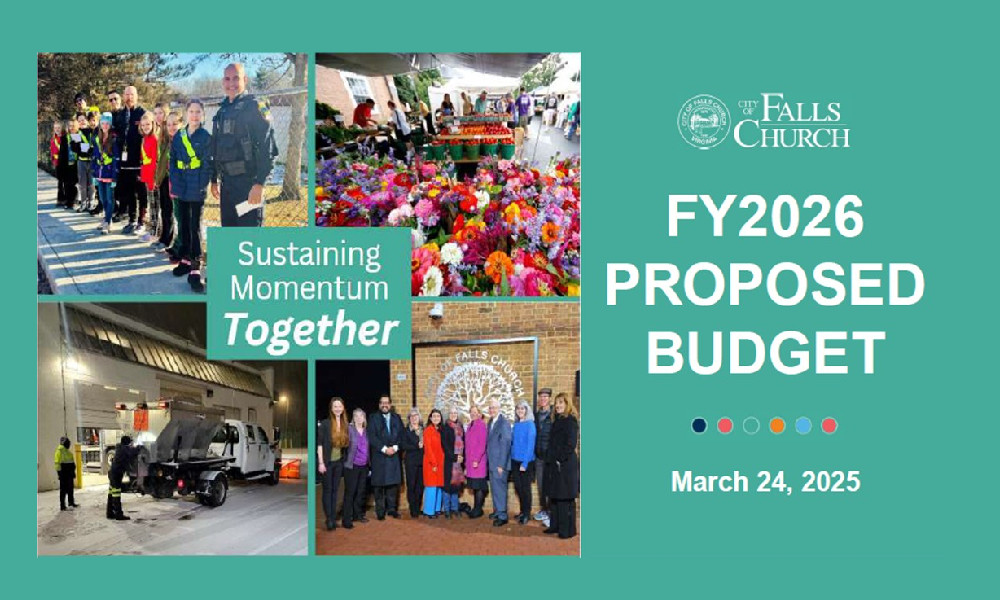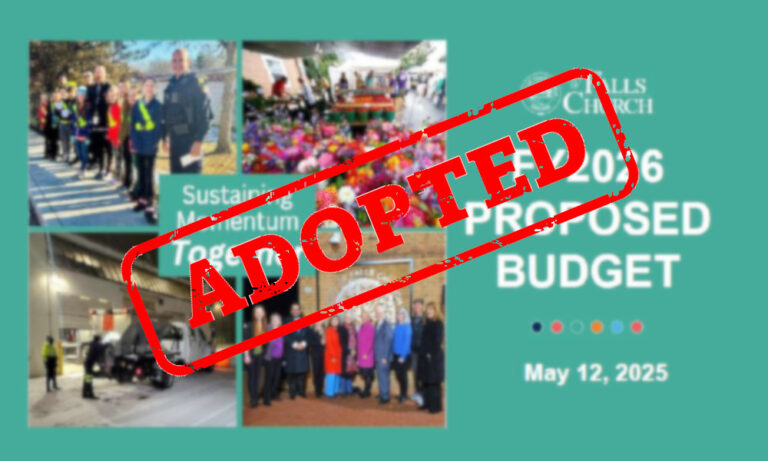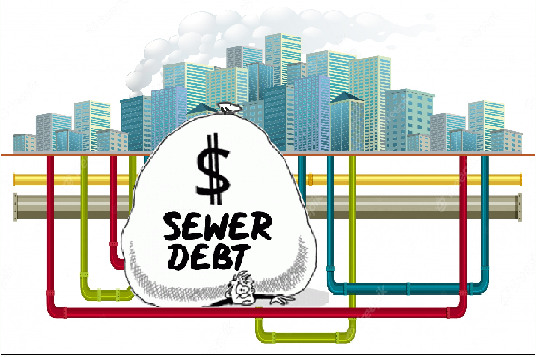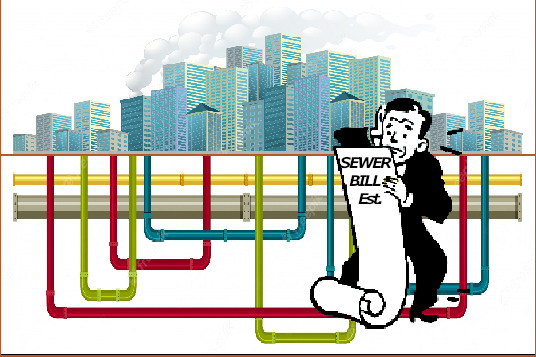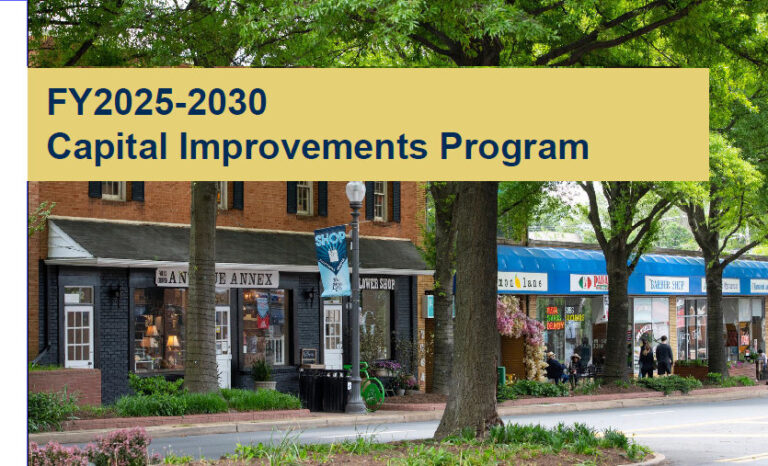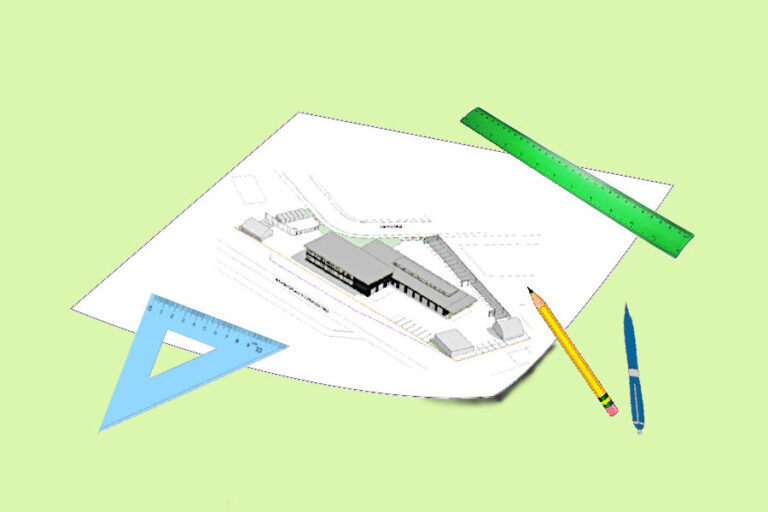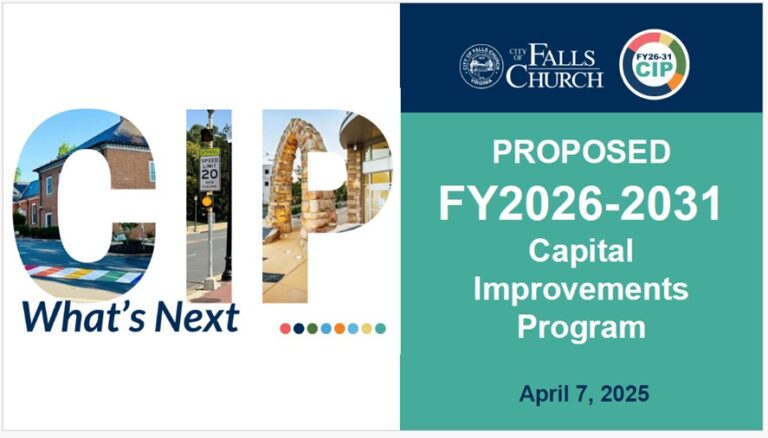Flash Update: FY2026 Budget – Proposed Real Estate Tax Rate Reduction is Gone!
Update
For the April 14 City Council first reading on the FY 2026 budget, City staff have increased the proposed real estate tax rate from the $1.185 discussed at the previous work session to $1.21 per $100 of real estate value, the same as for FY2025.
The change is due to a reduction in local taxes in the third quarter of 2025, and a currently projected $1.2 million decline in City revenues for FY2026 relative to previous projections. Staff pointed to uncertainties regarding Federal spending cuts, Federal employee layoffs, and the economic outlook due to recent U.S. tariff actions in noting that further steps to reduce FY 2026 budget expenditures also may be necessary. The higher tax rate proposal is designed to give the City additional flexibility in responding to the external environment prior to the May 12, 2025, final consideration of the budget and tax ordinances. Real estate tax rates conceivably can be lowered after first reading but not raised.
Reference
FY2026 Tax Ordinance, April 14, 2025.
The FY2026 Budget Proposal – 6.5% Increase for the City, 5.6% Increase for the Schools
April 2, 2025
Summary
Compared to FY2025, the overall proposed FY2026 budget for the City decreased 2.8% to $133.9 million, primarily due to reduced transfers for capital improvement projects and lower debt service costs with FY2025 payoff of the Mary Ellen Henderson Middle School bonds .
The proposal followed the City Council’s budget guidance in December, showing a 6.5% increase for the general government and a 5.6% increase in the revenue transfer to the schools. The overall school budget, including state and federal grants, increased 7.1%. In accordance with the revenue sharing agreement to split local taxes equally, but excluding investment income and other non-tax revenues, the general government is 43% of the budget while the school transfer constitutes 42%.
The total real estate assessment increased 10.5%, higher than expected. This allowed for a 2.1% decrease in the tax rate from $1.21 to $1.185 per $100 of assessed value. The overall market appreciation for residential units was 6.85%.
Staff has been asked to consider charging for trash pickup separately. The Mayor and some Council members believe that a fee-based system would be more equitable to the condo owners and commercial property owners who do not receive City trash services.
All City government and school employees will receive a 5% salary increase. The school staff’s increase is based on a collective bargaining agreement.
Sewer and stormwater fees will increase 2.7%, to keep up with inflation (2.6%).
Background
The FY2026 budget proposal was presented at the March 24, 2025, City Council meeting. School Board Chair Tate Gould provided highlights of the School Board’s proposed budget, and City Manager Wyatt Shields offered the general government’s recommended budget.
The annual budget also includes the six-year Capital Improvements Program (CIP), the City’s capital budget. This post focuses on the operating budget. The capital budget will be discussed in a separate post.
There will be two town halls where the public can ask questions – Thursday, April 3, at 12:00 noon and Thursday, April 24, at 7:00 pm. The final vote on the budget is scheduled for May 12. The FY2026 budget goes into effect on July 1, 2025.
A 2.5-cent tax rate decrease is still a tax increase for homeowners
Turning first to the most important budget decision for homeowners in the City, real estate taxes are going up. Overall assessments, including new construction, increased 10.5%. This significant increase allows the City to decrease its tax rate by 2.5 cents, or 2.1% from $1.21 to $1.185 per $100 of assessed value.
Residential property assessments, excluding new construction, increased 6.85%. This means that homeowners will see an average increase of 4.61%. To find out how your real estate taxes will be affected, if the assessment changes by x%, the tax change is a little less than (x – 2.1) %.
The table below shows the changes in total assessment value by category. This includes new construction. For example, the 8.22% increase in single-family assessment value includes teardowns, reconstruction, and new construction. As there have not been any new town homes built in the last year, the 6.08% increase reflects the average assessment increase for existing town homes. The commercial properties market value increase was only 2.37%. The 2.1% tax reduction means that existing commercial properties will have a flat or very small increase in taxes from the previous year.
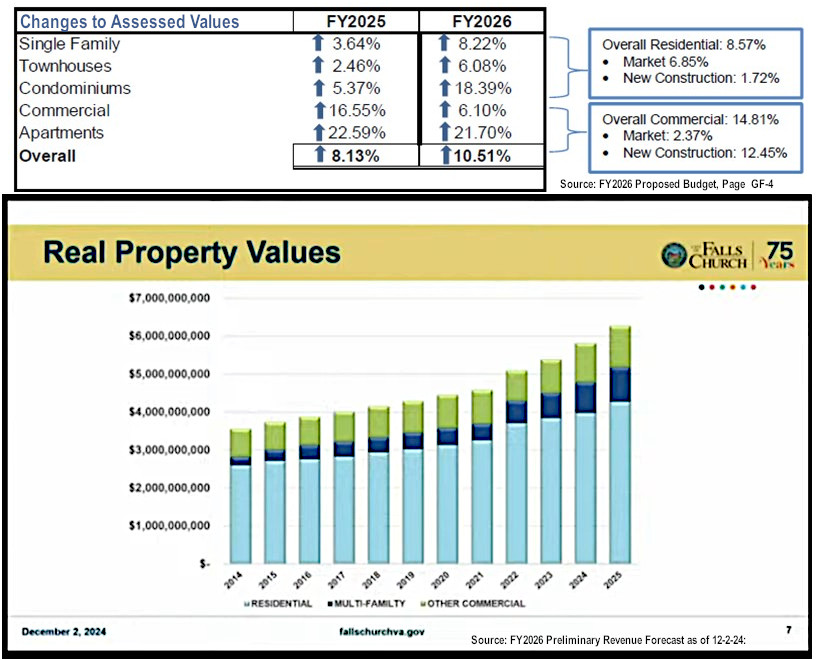
Increase in other taxes
- Sanitary sewer rates will increase 2.7% from $10.86 to $11.15 per 1,000 gallons. This equates to about $14 per year per household. The budget further proposes that sewer availability fees for new connections to the sewer system increase by 2.7%.
- Stormwater fees will also increase 2.7% from $20.77 to $21.33 per 200 sq ft. This is about $7 per year for the average homeowner.
These increases reflect the annual regional inflation rate of 2.6% and do not account for future utility capital expenditures. The City expects to issue $22.6 million in bonds over the next six years to increase the sewer capacity. The debt is expected to be repaid through higher sewer rates.
Charging separately for trash pickup
Not included in the proposed budget but raised as a possibility by Mayor Letty Hardi and Vice Mayor Debora Schantz-Hiscott was the “decoupling” of solid waste costs from the tax rate. Doing so would “ensure we are only charging single-family homes for the services received for trash removal” rather than all residences, including condominium owners and households residing in multifamily buildings, which are not now served, Ms. Schantz-Hiscott said.
Council Member David Snyder objected to “taking services away” as a means of achieving equity for condominium owners and multifamily residences. He recommended, instead, that trash pickup remain a service covered under the tax rate but that it be provided to all City residents.
Mr. Shields said City staff will plan to present this concept to the public at the first budget town hall on April 3 and to discuss it in depth with the City Council at its April 14 work session. The Pulse published a post on an earlier Council discussion on this topic in City Council Mulls Moving to a Fee-Based System for Solid Waste and Introducing an Organics Bin, October 14, 2024.
No new major initiatives in $134 million budget
Mr. Shields and the City Council acknowledged the economic uncertainties in the region for residents and businesses. An estimated 16% of the City’s residents are federal employees, and many more depend on federal contracts. Some people are already unemployed, and many are uncertain about their jobs. Accordingly, the proposed budget includes a $500,000 revenue contingency, which some Council members thought might not be enough.
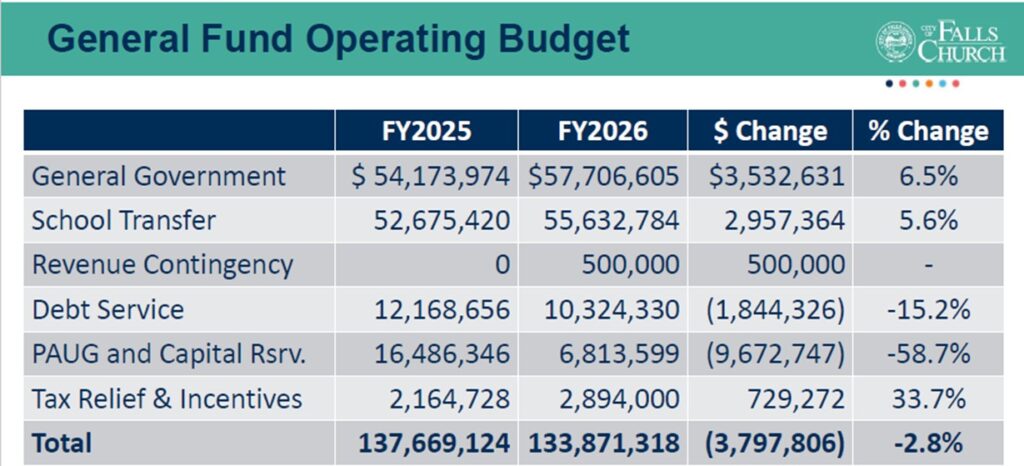
Because of these uncertainties, the FY2026 budget does not propose any major new initiatives though it does maintain operations at FY2025 levels. The school transfer of $55.6 million represents an increase of 5.6% over FY2025, and the general government budget of $57.7 million shows an increase of 6.5%. These increases are driven by the 5% salary increases and growth in enrollment and population.
The total City budget, including debt service, capital spending, and other non-operating expenditures, is $133.9 million, a $3.8 million (2.8%) reduction from FY2025. This reduction reflects reduced debt service by $1.8 million as the bonds for Mary Ellen Henderson Middle School were paid off in August 2024, and much lower capital expenditures. FY2025 was unusual in terms of capital expenditures as staff pushed to carry out several capital improvement projects throughout the City.
How did the City and the schools arrive at this budget?
The City and the School Board have an informal revenue sharing agreement, followed since FY2019, that states that the local tax revenue will be equally split between the City General Government and the School Board. Revenues from licenses and permit fees, investment returns, and other special-purpose funding are excluded from this arrangement.
At the December 2, 2024, City Council work session, City Finance Director Kiran Bawa projected a 5.9% growth in local taxes that was primarily driven by a real estate tax growth forecast of 6.9%. Using the current tax rate of $1.21, the projected increase in tax revenue amounted to $5.9 million. (Read the Pulse post FY2026 Budget Guidance For Falls Church City Expects 5.5-6% Revenue Growth Yet Projects $2 Million Shortfall, December 16, 2024.)
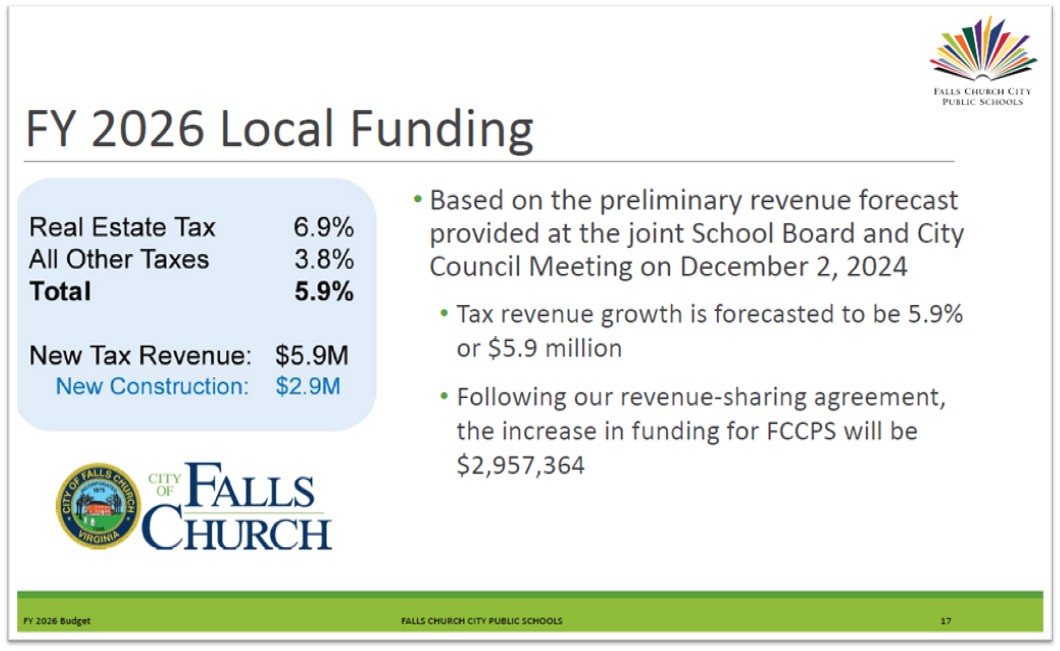
Therefore, the School Board limited its budget to an increase of $2,957,264 (half of the projected increase in tax revenues). The general government budget increased $3,532,631, slightly higher because of the additional investment income and other revenues omitted from the revenue sharing agreement.
At the March 24, 2025, Council meeting, Mr. Shields reported that the real estate assessments came in higher than the December projections. The overall assessment increase was 10.5%, not 6.9%. However, both the City and the schools did not increase their proposed budgets, allowing for the recommended reduction in the real estate tax rate. The school transfer represents 42% of the overall budget, while the general government comprises 43%.
The cost drivers
For both the schools and the general government, the primary cost driver is a 5% salary increase for all employees. The schools’ compensation increase was negotiated through a collective bargaining agreement. In addition, positions that were previously covered by the 2021 American Rescue Plan Act (ARPA) grants, vacancy savings, and other one-time funding are now being covered by City taxpayers.
For the City, another cost driver is the increase in the cost of contracts with Arlington County and Fairfax County for services that are not provided by the City, such as judicial services and fire and emergency services. These costs are increasing by $903,000 in FY2026. Mr. Shields said the new Arlington County Fire contract went up $500,000 from FY2025 to FY2026.
A lower debt service, for now
The City made the final payment in FY2025 for the 20-year bonds issued for the construction of Mary Ellen Henderson Middle School, resulting in a large decrease in debt service of $1.8 million for the fiscal year ahead. However, these savings are not returned to taxpayers. Instead, taxpayers must pay a greater share of the $6 million debt service for the Meridian High School bonds because the West Falls project, whose lease and tax revenues help pay for the bonds, will generate only $2.2 million in FY2026.
In past four years, West Falls generated $4.6 million toward the debt service. (See the financial details in the Pulse post The History of West Falls – Part 2. The Challenges of Negotiating a Public-Private Partnership (2018 to 2022 and ongoing …), November 13, 2024.) The City Manager expects that West Falls will reach its target tax revenue of $4 million in about three years.
The six-year Capital Improvements Program expects a total of $57.6 million of debt to be issued in the near future, driving up the debt service. The future bond issues are:
- $30 million for a new Property Yard in FY2028-2029.
- $22.6 million for sewer infrastructure from FY2026-FY2031.
- $5 million for replacing the fire station roof in FY2031.
The general government operating budget
The general government operating budget is $57.7 million, an increase of $3.5 million (6.5%) over FY2025. Apart from the 5% salary increase, the general government plans to maintain most program spending at FY2025 levels. New items include:
- $700,000 for roadway maintenance, to be covered by investment income.
- $150,000 to improve the financial systems for online payments and building permit processing.
- An additional 3.33 full-time equivalent (FTE) in permanent staffing. The increase in total staffing cost, the 5% salary increase and 3.33 FTE, is $2.1 million.
The total roadway maintenance spending in this budget is $2.2 million: $1.4 million for paving, bike lanes and pedestrian crossings; $300,000 for sidewalk repair; and $300,000 for traffic signals and streetlights. An additional $200,000 has been budgeted for the associated project management costs.
The increase in the City general government permanent staff by 3.33 FTE covers positions previously funded with ARPA (federal) grants, vacancy savings, and one-time money. The City also has temporary positions that are not included in the FTE counts. In FY2025, the City initially proposed adding 15 FTE before reducing this headcount to 12 FTE. It has been slow to fill existing vacancies, including department heads. The City staff total 252.03 FTE in FY2026.
The proposed budget allows the police department to fund a professional standards manager to work toward ensuring that the Police Department is accredited. This was a concern raised in the FY2025 budget.
The Affordable Housing Fund will receive $500,000, the same as in FY2025.
Mr. Shields encouraged the public to review and comment on the budget and CIP available on the City’s website.
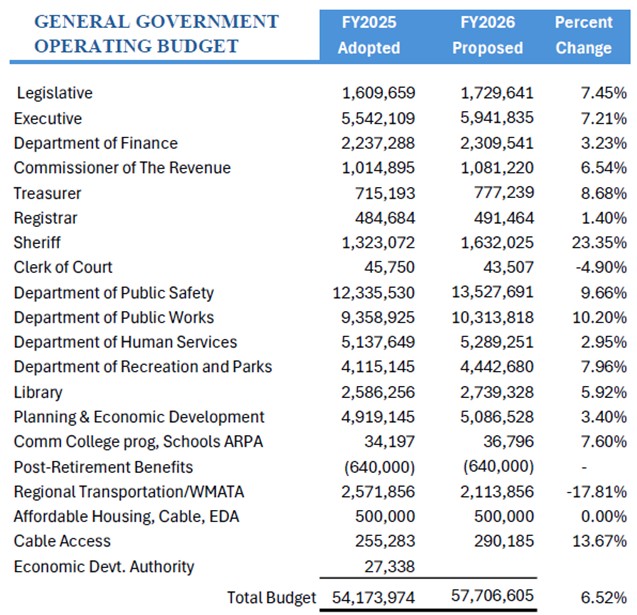
The school budget
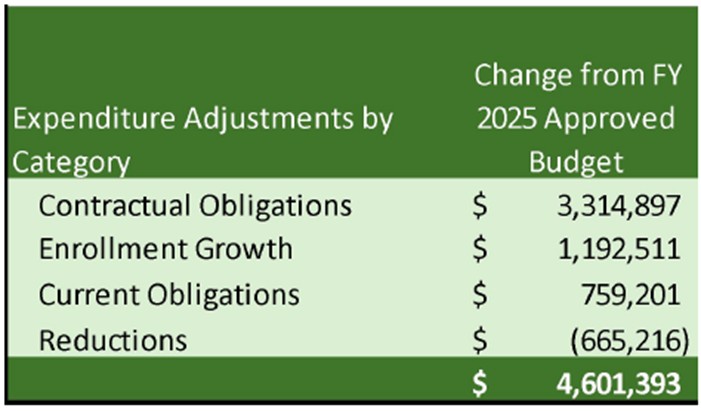
Collective bargaining agreements with the school staff include a 5% salary increase. These contractual obligations added $3.3 million to the budget. $1.2 million in increased costs are associated with higher enrollment. The schools have planned for an increase of 159 students, driven by the completion of the Broad and Washington apartments, Founders Row II, and the West Falls apartments and condominiums. However, Superintendent Peter Noonon expressed concern that new enrollment could exceed this number; the schools already have 32 more students than their projected enrollment for FY2025.
The overall school budget increased by $4.6 million (7.1%) to $69.5 million, $55.6 million to be funded by the City with the remainder from state and federal funds and School Board reserves.
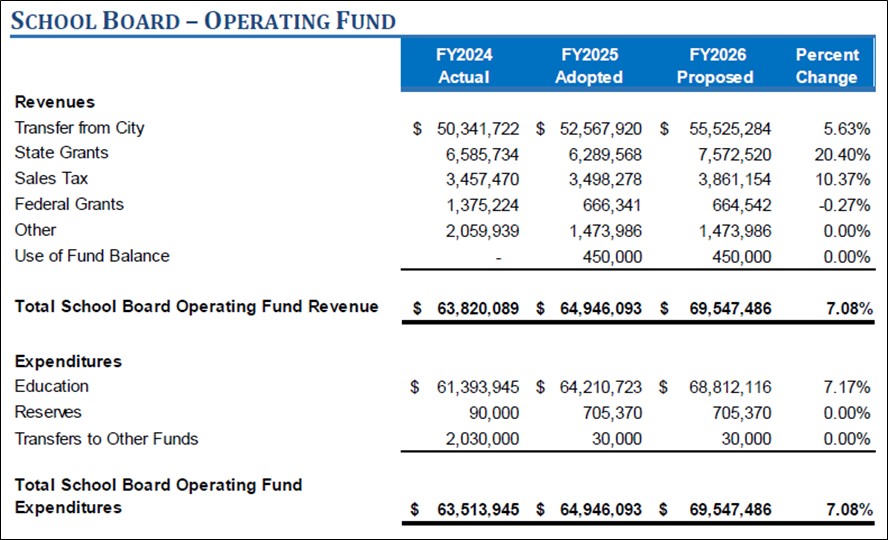
A summary of the City of Falls Church proposed FY2026 budget
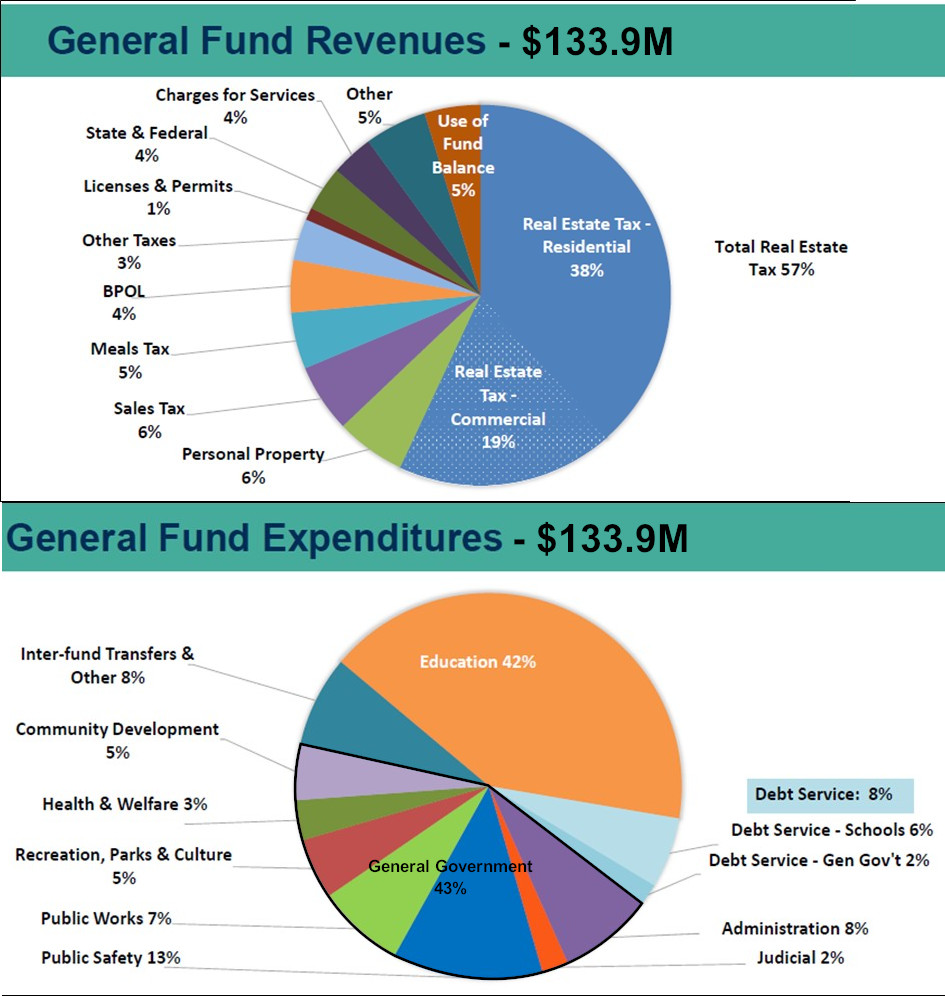
References
- FY 2026 School Advertised Budget Presentation. March 24, 2025.
- City Council meeting, March 24, 2025. This official video will not display properly on a small screen as it contains the agenda.
- City Council meeting, March 24, 2025. YouTube video.
- FY2026 Budget staff report , March 24, 2025.
- FY2026 Proposed Budget for Posting. Official budget document.
- City Managers FY2026 Budget Presentation, March 24, 2025.
- FY2026 Preliminary Revenue Forecast as of 12-02-24. Presentation at the City Council meeting, December 2, 2024.
- City Budget Webpage.

